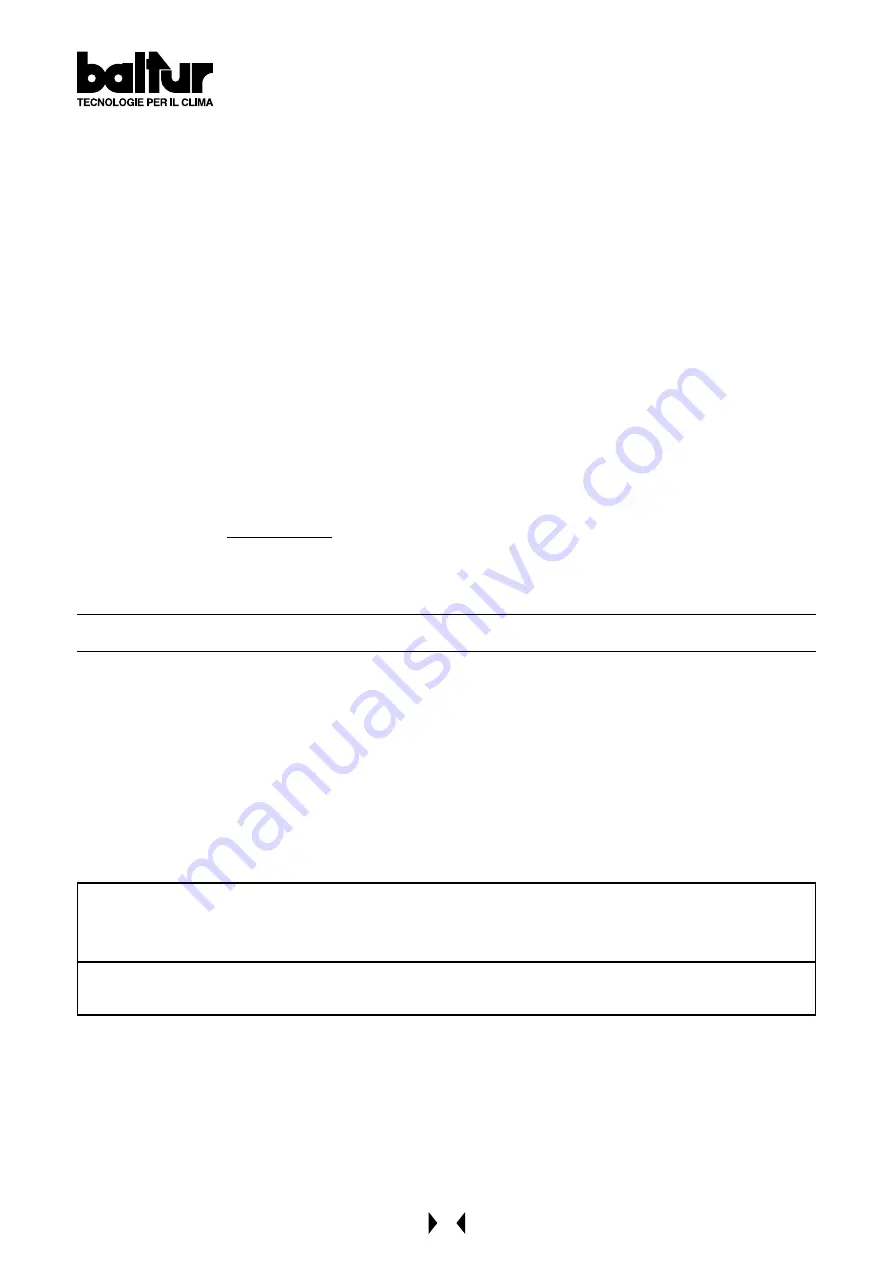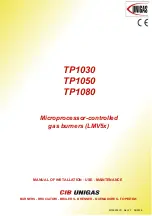
38
The servomotor which regulates delivery (fuel/air) commends an increase in the delivery of fuel and combustion
air at the same time. The increase in fuel delivery is determined by a disk with a varied profile which, by rotating,
can determine a greater compression of the return pressure regulator spring and thus an increase in the pressure
itself. When the return pressure increases, there is also a corresponding increase in fuel delivery.
There should also be an adequate increase in combustion air to meet the increase in fuel delivery.
Adjustment can be carried out at first regulation by operating the screws which vary the profile of the command
disk of the combustion air regulator. Fuel and combustion air delivery both increase at the same time until they
reach maximum value (fuel pressure at the return pressure regulator is equal to about 18 ÷ 20 bar if the pressure
at the pump is at the value of 20 ÷ 22 bar).
Fuel and combustion air delivery remain at maximum value until the boiler temperature (pressure, if steam boiler),
approaches the value at which it has been set and causes the servomotor regulating delivery (fuel/air) to reverse
its previous sense of movement. The return movement of the servomotor causes a reduction in fuel delivery and
a relative reduction in combustion air until they reach minimum value.
Should the maximum temperature (pressure, if steam boiler) be reached even with fuel and combustion air
delivery at a minimum, the thermostat (pressure, if steam boiler) will intervene when the value at which it has been
set is reached, and bring the burner to a standstill. When the temperature (pressure, if steam boiler) drops below
the intervention limit of the “shut down” device, the burner will start up again as previously described.
During normal operations, the thermostat (or pressure switch) of the 2nd stage is aware of load variations in the
boiler and automatically requests the servomotor regulating delivery (fuel/air) to make an adjustment in the fuel
delivery and in the relative combustion air. With this manoeuvre, the delivery regulating system (fuel/air) reaches
a position of equilibrium which corresponds to a fuel delivery and a relative combustion air delivery equal to the
quantity of heat required by the boiler. It should be kept in mind that the field of variation in output obtainable with
a good combustion is, as an indication, from 1 to 1/3 of the maximum output given on the rating plate.
Note: The air pressure switch must be set when the burner is started up and must be in function with the pressure
value verified during operation with the ignition flame.
DESCRIPTION OF MODULATING OPERATION (BT...MNM) (See BT 8712/3)
While fuel oil is being pre-heated, voltage passes through the pre-heater regulation thermostat and reaches the
coil of the elements remote-switch.
This remote-switch is cut-in and takes current to the pre-heater elements which heat the fuel inside the pre-
heater.
The elements that heat the pump and atomizer unit (only for the ...D version) are also cut-in through panel
switch ( I ). The minimum level thermostat for the pre-heater is cut-in when temperature reaches the level to which
it is set. The equipment is cut-in only when the temperature at which elements are cut-off is reached in the pre-
heater (the thermostat regulation contact opens). This means fuel oil in the pre-heater must be at maximum
temperature. The burner command/control equipment (cyclic relay) is therefore cut-in by the pre-heater regulation
thermostat when the latter cuts-off the elements by switching off the relative remote-switch.
Control box specifications
Control box
& relative
Programmer
LAL 1.25
Cyclic relay
Safety Time
in seconds
5
Pre-Ventilation & Oil
Pre-circulation Time
in seconds
22,5
Pre-ignition Time
in seconds
2,5
Post-ignition
Time
in seconds
5
Time between
1st flame & Start
of Modulation
in seconds
20
Summary of Contents for BT 75 DSPN /D
Page 25: ...25 APPARECCHIATURA DI COMANDO E CONTROLLO LAL N 7153 Rev 07 1996...
Page 26: ...26 N 7153 Rev 07 1996 APPARECCHIATURA DI COMANDO E CONTROLLO LAL...
Page 27: ...27 N 7153 Rev 07 1996 APPARECCHIATURA DI COMANDO E CONTROLLO LAL...
Page 28: ...28 N 7153 Rev 07 1996 APPARECCHIATURA DI COMANDO E CONTROLLO LAL...
Page 29: ...29 N 7153 Rev 07 1996 APPARECCHIATURA DI COMANDO E CONTROLLO LAL...
Page 30: ...30 N 7153 Rev 07 1996 APPARECCHIATURA DI COMANDO E CONTROLLO LAL...
Page 31: ...31 N 7153 Rev 07 1996 APPARECCHIATURA DI COMANDO E CONTROLLO LAL...
Page 32: ...32 N 7153 Rev 07 1996 APPARECCHIATURA DI COMANDO E CONTROLLO LAL...
Page 49: ...49 N 7153 Rev 04 1996 INSTRUCTIONS LAL CONTROL BOX...
Page 50: ...50 N 7153 Rev 04 1996 INSTRUCTIONS LAL CONTROL BOX...
Page 51: ...51 N 7153 Rev 04 1996 INSTRUCTIONS LAL CONTROL BOX...
Page 52: ...52 N 7153 Rev 04 1996 INSTRUCTIONS LAL CONTROL BOX...
Page 53: ...53 N 7153 Rev 04 1996 INSTRUCTIONS LAL CONTROL BOX...
Page 54: ...54 N 7153 Rev 04 1996 INSTRUCTIONS LAL CONTROL BOX...
Page 55: ...55 N 7153 Rev 04 1996 INSTRUCTIONS LAL CONTROL BOX...
Page 56: ...56 N 7153 Rev 04 1996 INSTRUCTIONS LAL CONTROL BOX...
Page 73: ...73...
Page 74: ...74...
Page 75: ...75...
Page 76: ...76...
Page 77: ...77...
Page 78: ...78...
Page 79: ...79...
Page 80: ...80...
Page 81: ...81...
Page 82: ...82...
Page 83: ...83...
Page 84: ...84...
Page 86: ......
Page 87: ......
Page 88: ......
Page 89: ......
Page 90: ......
Page 91: ......
Page 92: ......
Page 93: ......
Page 94: ......
Page 95: ......














































